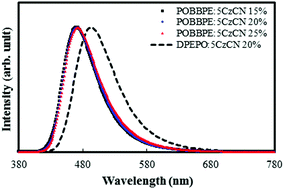Blue-shifted emission color and high quantum efficiency in solution-processed blue thermally activated delayed fluorescence organic light-emitting diodes using an intermolecular interaction suppressing host decorated with blocking groups
Abstract
A high triplet energy material with the ability to suppress intermolecular interactions was synthesized as a host for a blue thermally activated delayed fluorescence (TADF) emitter for blue-shifted emission color and high quantum efficiency in solution-processed TADF organic light-emitting diodes. The host material, (5-(tert-butyl)-2-(4-(tert-butyl)phenoxy)phenyl)diphenylphosphine oxide (POBBPE), was designed to have a phenoxyphenyl core structure for high triplet energy, a diphenylphosphine oxide group for electron transport, and two tert-butyl units to prevent intermolecular interaction. Solution-processed blue TADF devices were developed using the POBBPE host and 2,3,4,5,6-penta(9H-carbazol-9-yl)benzonitrile (5CzCN) as the emitter, and a high quantum efficiency of 23.3% was achieved. In particular, the color coordinates of the solution-processed POBBPE:5CzCN devices were (0.16, 0.23), which were significantly blue-shifted compared to the color coordinates of (0.17, 0.31) from a previous 5CzCN device fabricated using a well-known bis[2-(diphenylphosphino)phenyl]ether oxide host.



 Please wait while we load your content...
Please wait while we load your content...